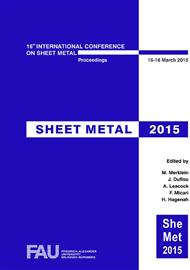p.115
p.123
p.131
p.139
p.147
p.155
p.163
p.173
p.179
Experimental and Numerical Determination of the Required Initial Sheet Width in Die Bending
Abstract:
So far, determining the necessary precut dimensions of metal sheets prior to bending has been an unsolved question. During the last decades numerous calculation methods have been suggested. However, comparing these different methods indicates that different calculation methods suggest diverging precut dimensions. Especially in roll-forming, where multiple bend operations occur within the same bend part, these differences between several calculation methods can add up to some millimetres. The accuracy of presently available methods can hardly be compared. Thus an optimized method is needed. One possibility to determine the initial sheet width is identifying the position of the unlengthened layer in the bend zone. This study compares the position of the unlengthened layer determined in experiments and numerical simulations for different bend geometries and materials. The results indicate that even state of the art measuring technique is not accurate enough to determine the position of the unlengthened layer properly. Due to high measurement uncertainties, numerical simulations are required to assess the influence of geometry or material parameters on the position of the unlengthened layer. However, combining numerical and experimental results shows that the geometry of the bend part influences the position of the unlengthened layer and thus the required precut dimension. In contrast, a significant influence of material strength on the position of the unlegthened layer was not found.
Info:
Periodical:
Pages:
147-154
Citation:
Online since:
March 2015
Authors:
Keywords:
Price:
Сopyright:
© 2015 Trans Tech Publications Ltd. All Rights Reserved
Share:
Citation:


